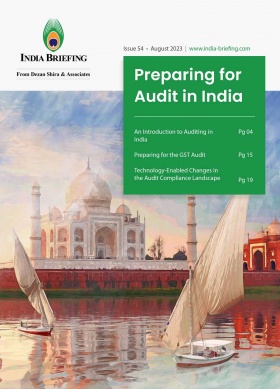India’s Auto Component Manufacturing Success and its Vision for EV Adoption
In recent years, India’s auto component manufacturing industry has seen a surge in Indian OEM suppliers, strengthening its position in the global automotive supply chain. We discuss key growth drivers and prospects for foreign enterprises looking at India’s automotive market.
India’s automotive industry is a major contributor to the country’s production economy. Supporting this dynamic industry is the auto component manufacturing (ACM) segment. In recent years, the number of Indian OEM suppliers in the ACM segment has grown, making India a noteworthy player in the global automotive supply chain.
Market outlook
As of 2023, the Indian auto component industry is valued at approximately US$57 billion and is expected to reach US$85 billion by 2026, according to data from the Indian Investment Grid, propelled by rising demand, product quality upgrades, and enhanced competitiveness.
Within India, the ACM market has made substantial contributions to the automotive industry, accounting for over 2.3 percent of India’s GDP. Moreover, it employs more than 1.5 million people directly and indirectly, making it a critical driver of employment in the country.
The automotive component industry experienced its fastest turnover growth, surging by 33 percent to reach INR 5.59 trillion in the fiscal year 2022-23 (FY23). This remarkable expansion was attributed to pent-up demand, improved raw material supply, and increased sales of larger vehicles, particularly sport utility vehicles (SUVs). The export of auto components from India increased by 5 percent in FY23, reaching a total of US$20.1 billion, per the Automotive Component Manufacturers Association of India (ACMA).

The global sentiment towards sourcing from India has become notably positive. Export growth in FY23 was driven by this positive sentiment, even in the face of recessionary trends in key markets, and also following the diversification strategy known as “China+1.”
Besides, traditional components like castings, forgings, and injection modules are expected to find export-oriented production opportunities in India, as they may not have a place in Western markets.

Sub-sectors in India’s auto component manufacturing industry
The Indian auto component manufacturing industry is divided into several sub-sectors, each contributing significantly to the overall automotive industry’s growth. These include engine and transmission parts, electrical and electronics components, suspension and braking systems, and interior and exterior components.
As of 2023, engine and transmission parts constitute 35 percent of the Indian ACM market, electrical and electronics components make up 30 percent, suspension, and braking systems account for 20 percent, and interior and exterior components contribute 15 percent to the market’s overall composition.
Further breakdown of these sub-sectors hints towards a burgeoning market ready to take over the gaps left within the global ACM trade. To bolster the industry further, the central government has come up with incentives to attract investors.
Some prominent Indian ACM companies include Bharat Forge (a global leader in metal forming), Motherson Sumi Systems (electrical distribution systems, mirrors, and polymer products), and Sundaram-Clayton (aluminum die-casting and machining for the automotive industry). These companies have consistently demonstrated excellence in manufacturing and have expanded their operations both domestically and globally.
Additionally, the Indian ACM sector has attracted major foreign players, such as Bosch, Continental AG, and Magna International, who have invested significantly in India to leverage the country’s manufacturing capabilities and market potential.
As for key regions, Tamil Nadu, Maharashtra, and Haryana are among the key hubs for ACM manufacturing in India. In 2022-23, Tamil Nadu attracted investment proposals worth US$2.209 billion (INR 180.63 billion); it is capitalizing on legacy automotive industry expertise to enter the EV production segment.
All three states offer favorable industrial ecosystems, infrastructure, and skilled labor, making them attractive destinations for both domestic and international ACM companies. With the near saturation of the market in these states, component manufacturers are also eyeing untapped markets in other parts of the country.
Growth drivers for the ACM market in India
FDI
India’s pro-business policies have attracted substantial foreign investment in the automotive sector, with the government allowing 100 percent foreign direct investment.
Investments in the automotive sector have continued to grow, with US$5.2 billion in FDI inflow recorded in 2022, bringing the total FDI received by the sector to US$34.11 billion between April 2000 and December 2022, which is around 5.45 percent of the total FDI inflow received by India during the same period.
This influx of FDI has led to the development of advanced manufacturing facilities and technology upgrades, further enhancing India’s competitiveness in the global ACM market.
NATRIP
With an investment of US$388 million, the National Automotive Testing and R&D Infrastructure Project (NATRIP) has played a pivotal role in enhancing the testing and R&D capabilities of India’s automotive sector.
NATRIP’s state-of-the-art testing facilities ensure that Indian ACM manufacturers produce components that meet global standards.
Automotive Plan 2026
India’s Automotive Plan 2026 focuses on making the country a global manufacturing hub for vehicles and auto components.
Under this plan, the government has allocated US$10 billion for various initiatives, including infrastructure development, skill enhancement, and research and development. This plan is instrumental in setting the direction for the ACM industry’s growth and aligning it with global standards.
National Mission for Electric Mobility 2020
The National Mission for Electric Mobility 2020 aims to promote the use of clean energy vehicles in the country.
This initiative presents a significant opportunity for ACM manufacturers to contribute to the electric vehicle (EV) ecosystem by producing essential components, such as batteries, motors, chassis, and power electronics.
Recent trends in the Indian ACM industry
Exports
India’s ACM industry has witnessed impressive growth in terms of exports and turnover. Over the last five years, India’s auto component exports have grown at an average annual rate of 8.8 percent, with a total export value of US$15.2 billion in 2022, according to the India Brand Equity Foundation (IBEF).
This demonstrates the ACM industry’s global standing and its capacity to contribute significantly to India’s export revenue.


Main Export Markets for Indian Auto Component Makers in FY 2020-21
- Europe
Europe was the largest market for Indian auto component exports, constituting 32 percent of the total exports in FY21. Key European destinations for these exports were Germany, the UK, Italy, France, and Turkey. Europe also serves as a valuable source of high-quality, advanced products, capital infusion, and industry know-how for the Indian auto component sector.
- North America
North America ranked as the second-largest market for Indian auto component exports, contributing 31 percent to the total exports in FY21. Prominent North American export destinations include the USA, Mexico, and Canada. North America stands out as a center for innovation and research and development within the automotive industry.
- Asia
Asia emerged as the third-largest market for Indian auto component exports, accounting for 25 percent of the total exports in FY21. Major Asian export destinations include Thailand, China, South Korea, and Japan. Asia offers a rapidly growing and dynamic market with diverse opportunities and challenges for the Indian auto component industry.
Looking ahead, the prospects for India’s ACM market are promising. The industry is poised to capitalize on emerging opportunities, including the shift towards EVs and the increasing demand for sustainable mobility solutions.
India aims to achieve a 30 percent penetration of EVs in its automotive market by 2030, creating substantial growth potential for ACM manufacturers.
Indian shift towards electric vehicles
India’s transition to electric vehicles is a transformative shift for the ACM sector. The adoption of electric cars and public transport in India has the potential to generate a domestic market of EV batteries worth US$30 billion.
This ongoing shift, however, will foster innovation in the ACM industry, creating new OEM lines and export opportunities, besides catering to the domestic market. To meet such ambition, a cumulative investment of US$180 billion will be required for vehicle production and charging infrastructure by 2030.
Given the demand projected to 2025, 4 million EVs could be sold each year and 10 million by 2030.
FAME II
The central government has allocated US$1.4 billion for electric mobility under the Faster Adoption and Manufacturing of Hybrid and Electric Vehicles (FAME) II scheme, signaling its commitment to EV adoption and in turn creating new avenues for ACM manufacturers.
In March 2023, the Government of India approved US$97.85 million for 7,432 public fast charging stations under the FAME Scheme Phase II.
PLI scheme
The Production-Linked Incentive (PLI) scheme for the automobile sector proposes financial incentives of up to 18 percent to boost domestic manufacturing of advanced automotive technology products and attract investments in the automotive manufacturing value chain.
With an outlay of US$3.5 billion, this scheme is set to revolutionize India’s ACM sector.
Li-ion battery swap
The promotion of lithium-ion (Li-ion) battery-swapping technology is a critical aspect of India’s EV goals. This technology not only addresses range anxiety for EV consumers but also presents opportunities for ACM manufacturers to produce and service battery packs.
Carbon Emission Bharat Stage VI Norms
India’s adherence to Bharat Stage VI emission norms has led to increased demand for advanced emission control components. ACM manufacturers in India are well-positioned to supply these components, contributing to cleaner and more sustainable transportation.
Voluntary Vehicle Fleet Modernization Programme (V-VMP)
The V-VMP initiative encourages the scrappage and replacement of old vehicles with newer, more fuel-efficient ones. This program creates a demand for ACM products, particularly those related to engine efficiency and emissions reduction.
Recent data indicates that over 1 million vehicles were scrapped and replaced in 2022 under this program, creating a significant demand for ACM products related to engine efficiency and emissions reduction.
Advantages of investing in India’s auto components industry
Investing in India’s ACM sector offers several advantages:
- Skilled workforce: India boasts a skilled and cost-effective workforce, making it an attractive destination for manufacturing operations.
- Robust supply chain: India’s well-established automotive supply chain ensures a seamless flow of components and materials.
- Rising demand: With a growing middle class and urbanization, India presents a burgeoning domestic market for automotive products. The Indian automotive market is expected to be the third largest in the world by 2025.
- Strategic location: India’s strategic location provides easy access to other Asian markets, making it a vital export hub.
- Government support: The Indian government’s pro-business policies, like the PLI scheme, and manufacturing incentives make it conducive for foreign investments. These incentives attracted total 85 new investments in the ACM sector in 2022, including but not limited to: Maruti Suzuki, Hero MotoCorp, Tata Autocomp, Mitsubishi Electric, Toyota Kirloskar, Motherson Sumi, Bosch, and Lucas-TVS.
- Improved connectivity and reduced transportation costs: Infrastructure and logistics development, such as expansion and upgradation of highways, railways, ports, airports, and warehouses, have enabled faster and cheaper movement of raw materials, finished goods, and people across the country and abroad. This has improved the efficiency and competitiveness of the auto component industry.
- Increased market access and opportunities: Infrastructure and logistics developments have expanded the market reach and potential of the Indian auto component industry, which has been able to tap into new domestic and international markets, especially in emerging economies across Africa, Latin America, and Asia.
Potential challenges
While India presents numerous opportunities, investors should be aware of potential challenges:
- Regulatory landscape: Navigating complex regulations and compliance requirements can be challenging, although efforts are being made to streamline processes. Foreign firms are advised to seek local professional support in minimizing unforeseen costs and securing necessary approvals, besides tapping into the full range of incentives—from tax and hiring to production-linked fiscal and non-fiscal benefits.
- Competition: The ACM sector is competitive, requiring companies to innovate continually to maintain a competitive edge.
- Skill gap: Despite a large workforce, there may be a need for additional training and skill development, particularly in manufacturing and assembly involving advanced technologies.
Key takeaways
India’s rise in the global auto component manufacturing sector and its goals for EV adoption mark a significant shift in the global automotive market. With a strong indigenous ACM ecosystem, support for innovation and manufacturing of EVs, and government initiatives to support production and consumption growth, India is poised for a prominent role in the automotive sector’s future.
In the coming years, India’s ACM sector is expected to play a pivotal role in shaping the future of mobility, both within the country and on the global stage.
With the right mix of investment, innovation, and strategic planning, foreign companies and SME businesses in the auto component manufacturing industry are well-positioned to succeed in the Indian market.
With inputs from Melissa Cyrill.
About Us
India Briefing is produced by Dezan Shira & Associates. The firm assists foreign investors throughout Asia from offices across the world, including in Delhi and Mumbai. Readers may write to india@dezshira.com for more support on doing business in India.
We also maintain offices or have alliance partners assisting foreign investors in Indonesia, Singapore, Vietnam, Philippines, Malaysia, Thailand, Italy, Germany, and the United States, in addition to practices in Bangladesh and Russia.
- Previous Article India Will Not Impose Curbs on Imports of Laptops, PCs, Servers from Nov. 1
- Next Article Companies in India Can Hold Virtual AGMs and EGMs till September 30, 2024









